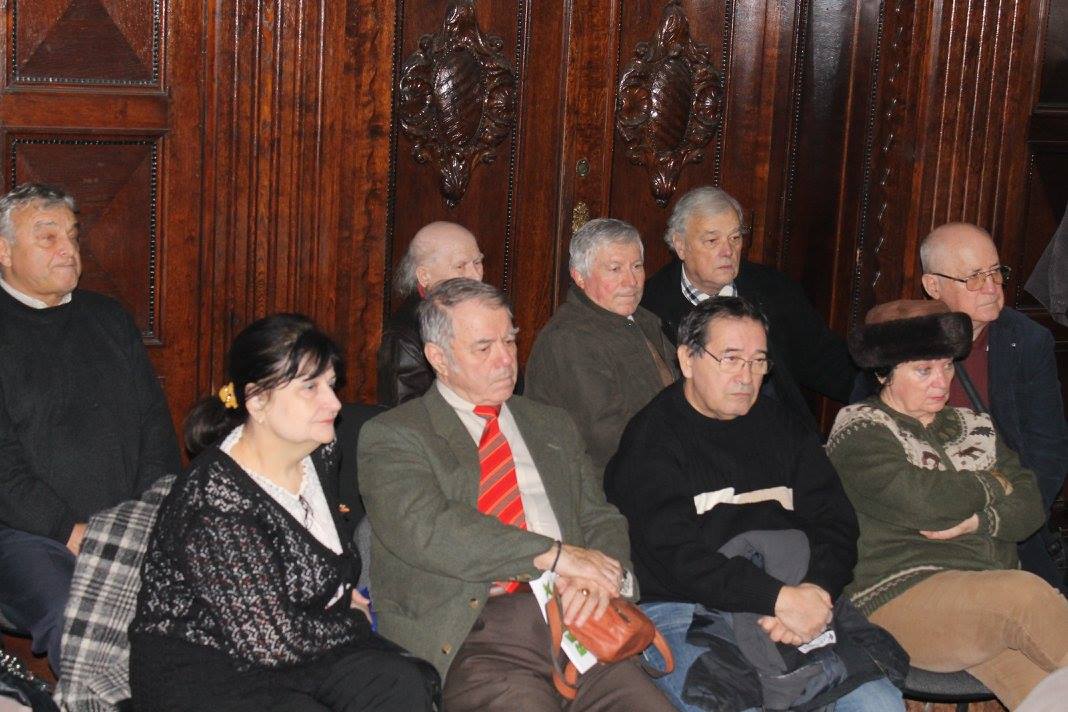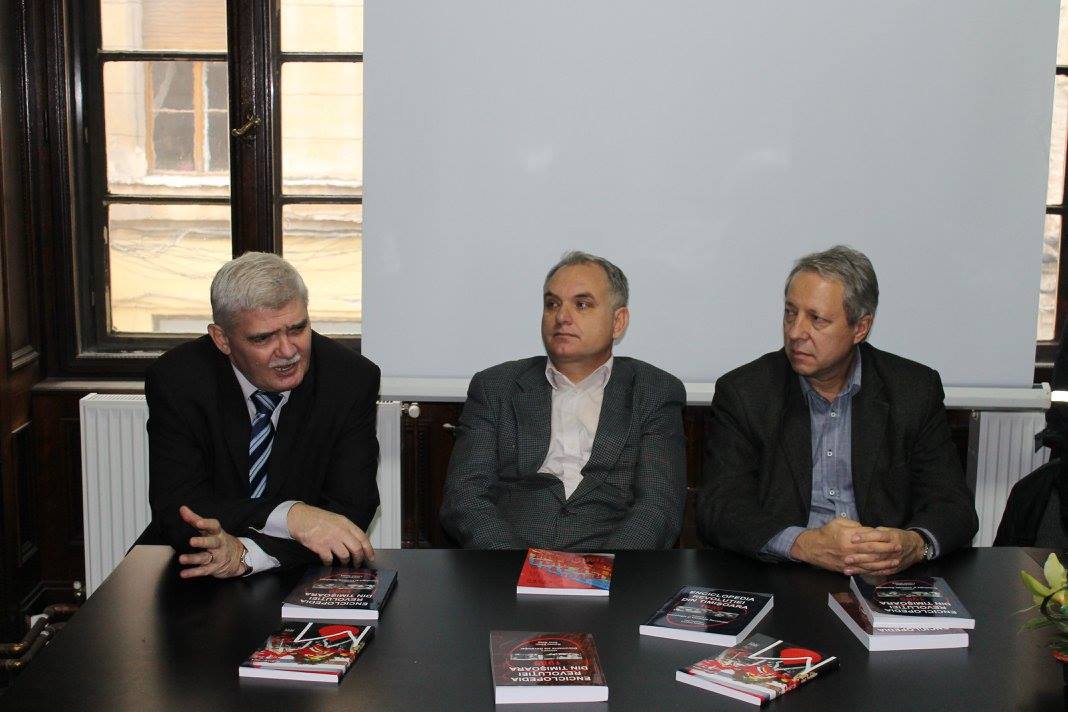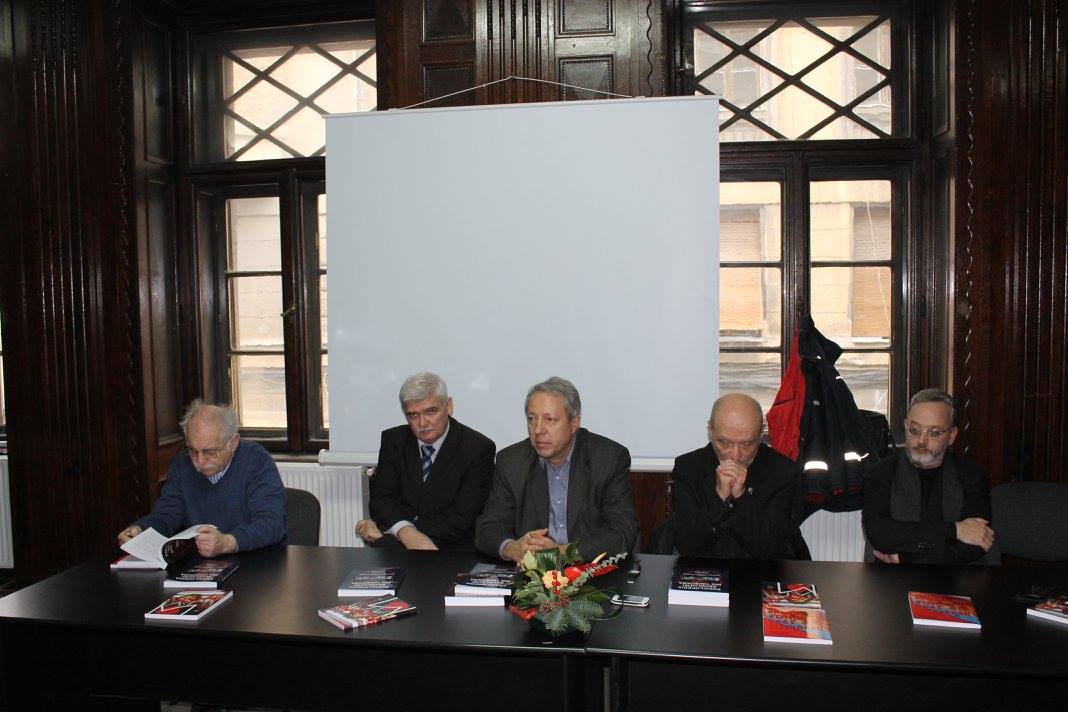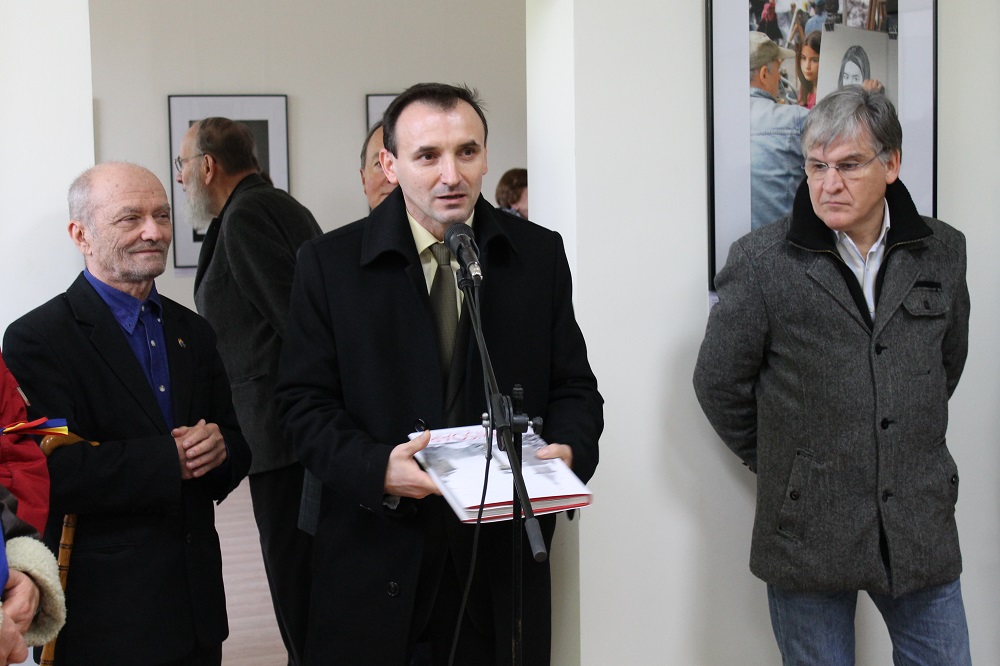Events from 2014
The Timişoara Revolution in encyclopedia
On December 12th 2014, at the „Orizont” Hall, “Memorialul Revoluţiei” launched its latest publications in the presence of the authors and the public concerned. We were very pleased, as we always do, that the launch has been welcomed by the Chairman of the Writers’ Union, Timişoara Branch, the literary critic and writer Mr. Cornel Ungureanu.
Together with the scientific and information journal, which has reached its 14th edition, “Memorialul Revoluţiei” managed to print 2 volumes of the Encyclopaedia of the Timişoara Revolution of 1989 which gathers 824 pages. The first volume titled The Chronology and the Victims of the Revolution is coordinated by Mr. Lucian Ionică, while the second volume, The Revolution Documents is signed by Mr. Romeo Bălan and Mr. Gino Rado.
The Encyclopaedia of the Timişoara Revolution of 1989 was a project started in 2012 and developed by the “Memorialul Revoluţiei” and the Faculty of Political Sciences, Philosophy and Communication Sciences of the West University of Timişoara. “The publishing staff gathers up the authors who dedicated a lot of time researching and documenting this theme and who published, through time, books and articles of priceless value. They are: Costel Balint, Romeo Bălan, Vasile Bogdan, Gino Rado, Titus Suciu, Lucian-Vasile Szabo and Dumitru Tomoni”, the writer and filmmaker Lucian Ionică, said, underlining the contribution of the Memorial team, „a competent team which passionately dedicated all its efforts to logistically guarantee the proper completion of this project. Alina Bânciu, Eugen Gheorghioiu, Loredana Tănasie and Cristina Tudor are the members of this wonderful team”.
The two volumes of the encyclopaedia involved…a huge amount of data and information, „inestimable documents collected by the “Memorialul Revoluţiei” during the 25 years since of our existence as an Association. And we are more than pleased that you, by what you write, fight so many currents and opinions and so many press manipulations regarding the Romanian Revolution that changed the destiny of Romania”, Mr. Traian Orban, Chairman of the “Memorialul Revoluţiei” Association argued. This idea is also supported by Mr. Gino Rado, vice-president of the institution and manager of the „Memorialul Revoluţiei 1989” Publishing House: „Obviously, I am very glad that we can publish and write, that we bring our humble contribution to somehow balance everything that is written about the Revolution, as we see that there are so many formal and informal accounts and writings mostly written by those who “fought” on the other side of the barricade. It’s been 25 years and there are still so many lies told and written about Revolution and it is our duty, the duty of all of us who have been living in Timişoara, to at least try to fight this by working as objectively as possible in our documentations and researches we conduct at the “Memorialul Revoluţiei” Association”.
Another publication launched at “Orizont” belongs to the writer and journalist Lucian-Vasile Szabo, who approaches a theme that has already been approached in 2013 in “The Timişoara 1989 Syndrome: Truth and Imaginary. Mass Media Communication Strategies in an Explosive Reality”. In the 200-page book, Lucian-Vasile Szabo restores, in “The Revolution of 1989 in the Hospitals of Timişoara”, the picture of the most important hospitals of the city that were involved in the operation of taking over and nursing the wounded, an operation which has been often accompanied, unfortunately, by their assiduous interrogation.
The book launch event ended with the 14th edition of our scientific and information journal where remarkable artists found a well-deserved place besides the series of our interesting articles and studies dedicated to the Revolution of 1989 and the communist regime. Among these artists we are proud to present Mrs. Herma Köpernik-Kennel, German writer and painter, who has absolutely fallen in love with pre- and post-December Romania and who approached communism and the Ceauşescu’s regime in a naive manner (from the point of view of her notable works, of course!) and Mrs. Suzana Fântânariu, a well-known illustrator in Timişoara, whose perspective on the Revolution is built from the… doorsteps, with all the significations that image could bring. The third name is the name of a man who comes from another branch of fine arts, the sculpture. It is Mr. Eugen Barzu, a resident of Timişoara, the author of the Heroes’ Column monument that has been created at the initiative of the “Memorialul Revoluţiei” Association.
The Timişoara Revolution in encyclopedia
Photography, in all its splendour.
Exhibition and presentation of a… photo album at the “Memorialul Revoluţiei”
On December 16th 2014, once with the consecration of the Heroes Column monument at the “Memorialul Revoluţiei din Timişoara”, two important events took place: the exhibition and presentation of a photo album. This time our entire attention was focussed on photography which is a good match for architecture. So, two events, one author: the architect Mihai Botescu from Timişoara, who once in a while “shifts” from architecture to photography. From this “betrayal” both get to win (the author above all!), because the images presented on the boards and in the album make nothing else but celebrate architecture.
Mr. Traian Orban, the Chairman of “Memorialul Revoluţiei” Association spoke about the happy circumstances that led to these events: “I saw the work of the Architect I saw the pictures he took for the heroes’ monument in the first years. Subsequently, I saw a series of photos which are 20-30 years old (highlighting his debut in the photographic art), and I asked Mr. Mihai Botescu to make an album. Honestly speaking, at first I was nervous… could we succeed in what we have planned? But I found in Mr Mihai Botescu the will, the understanding and the satisfaction that his work will be known by means of this album. I take this opportunity to express my deepest appreciation to Architect Mihai Botescu, for his collaboration with us, for assembling these wonderful photos in this space, in this «’89 Gallery», and I want to thank Mr. Pavel Vereş, who used the processed photos, typed and brought this album to life and, of course, Mr. Robert Şerban, who included some texts in this album on our request.”
The writer Robert Şerban spoke about the eyes of the photographer, not more than two, but experienced in catching on film, and then on camera, the ineffable that escapes those who are not initiated: „We know our city and, even if we are in love with it, and we are truly in love with it, we do not always see it as a professional photographer, as it is seen by a man who loves to watch, who knows to wait and who sees the exact moment to “steal” that fabulous image of the city. Architect Botescu made an incredible thing, take a look at the album and you will be absolutely charmed!”
The exhibition of Archit. Mihai Botescu gave the opportunity to writer and journalist Marcel Tolcea to take a look at the past, a past which was not too colourful, as we all know, especially those who were part of the vivid paintings of those times: “Before we enter this space, I was a character having the memory of a hideous decade. The moment I stepped into this space, I became a character with the luxury of normality, of looking at the world with a cloudless eye, of getting joy from the surrounding reality, of seeing beauty where, before 1989, I couldn’t even dream about it.”
Here is a quote of the brief characterization made by Archit. Mihai Botescu about himself and his own exhibition: ”I am not a photographer lured by facile experiences. On the contrary, I want to express myself as plastic as possible, maybe closer to the inter-war period than to the contemporary one.
Regarding the launch of this album, the idea was to put up an exhibition. For me what appears on the walls of this hall was and still is background with a rather decorative value. So, these are not images taken during the Revolution, they are, let’s say, landscapes: natural landscapes, urban landscapes. I made a selection, of course, a very subjective one, so I have chosen from my photo gallery a series of images which, initially, I wanted them to exclusively render the nature, as I love nature very much, and I am an inveterate mountaineer – I can’t really walk – but, in the end, I did what I did and I turned back to architecture, with a piece of detail, with a piece of insight!”
Adina HORNEA ABRUDA
Evenimente din 2014
Revoluţia de la Timişoara în enciclopedie
Revoluţia de la Timişoara în enciclopedie
Vineri, 12.12.2014, în sala revistei Orizont a Uniunii Scriitorilor din România, filiala Timişoara, au fost lansate în spațiul public cele mai noi cercetări despre Revoluția de la Timișoara din 1989.
Volume lansate:
Enciclopedia Revoluţiei din Timişoara 1989, volumul I, Cronologia şi victimele Revoluţiei, coordonator Lucian Ionică;
Enciclopedia Revoluţiei din Timişoara 1989, volumul II, Documente ale Revoluţiei, coordonatori Romeo Bălan şi Gino Rado;
Revoluţia din 1989 în spitalele timişorene, autor Lucian-Vasile Szabo;
Revista Memorial 89, nr. 2 (14) 2014.
Volumele sunt realizate în cadrul Asociației Memorialul Revoluției 16-22 Decembrie 1989 Timișoara, cu colaborarea unor specialiști ai Facultății de Științe Politice, Filosofie și Științe ale Comunicării din cadrul Universității de Vest din Timișoara.
Volumele sunt realizate în cadrul Asociației Memorialul Revoluției 16-22 Decembrie 1989 Timișoara, cu colaborarea unor specialiști ai Facultății de Științe Politice, Filosofie și Științe ale Comunicării din cadrul Universității de Vest din Timișoara.
Timp de 25 de ani, s-a scris mult şi cu pasiune despre Revoluţia de la Timişoara. S-au publicat articole de ziar, studii în reviste, cărţi cu mărturii, pagini de jurnal, serii de documente, analize şi sinteze. La acestea s-au adăugat emisiuni de radio şi televiziune, precum şi site-uri specializate. Au fost consemnate acţiunile populaţiei în confruntare cu forţele de represiune, emoţia şi atmosfera extraordinară de atunci, transformate, pentru cei ce au demonstrat în stradă, într-o bucurie nemăsurată. Alte lucrări au prezentat opiniile unor persoane aflate în cealaltă tabără, şi care au oferit o altă perspectivă asupra evenimentelor. S-a adunat astfel o mare cantitate de informaţii şi de interpretări, de valori diferite. Acum, după atât timp, a încerca să faci o selecţie, să cauţi o ordine şi o logică a faptelor este foarte dificil şi poate chiar riscant. Dar este cu atât mai necesar.
Enciclopedia Revoluţiei de la Timişoara este o lucrare în trei volume, care îşi propune să ofere o imagine a Revoluţiei de la Timişoara, să prezinte cât mai obiectiv şi sintetic, într-o manieră accesibilă, informaţii despre acele zile dramatice. Să călăuzească cititorul prin mulţimea de date, uneori contradictorii, ajutându-l să găsească ceea ce este esenţial şi, totodată, să-i amintească întrebările rămase fără răspuns. Primul volum cuprinde o cronologie detaliată a evenimentelor din Timişoara din perioada 15-22 decembrie 1989, precum şi consemnarea victimelor. Al doilea volum oferă o culegere a celor mai semnificative documente, accesibile până în acest moment, privind Revoluţia de la Timişoara. Al treilea volum reprezintă un dicţionar ale cărui articole oferă informaţia necesară, inclusiv cea bibliografică, referitoare la ceea ce s-a petrecut în capitala Banatului, în decembrie 1989.
Enciclopedia Revoluţiei de la Timişoara nu reprezintă un punct final al cercetărilor. Acum marcăm un moment cu valoare simbolică: trecerea unui sfert de secol. Orice semnalare a unor posibile omisiuni sau erori va fi binevenită, dacă se întemeiază pe dovezi. Opiniile şi convingerile personale nu le pot suplini. Uneori, chiar şi faptele, nu doar sensul lor, stau în cumpănă: sunt situaţii când relatările martorilor nu coincid, ba chiar se contrazic.
Documentele au şi ele incertitudinea lor: uneori nu ştii dacă n-au fost rescrise mai târziu, ori dacă cei ce le-au întocmit au consemnat realitatea, ori dacă nu s-au produs erori involuntare, explicabile datorită tensiunii din acele zile. Se poate ajunge astfel la impasul de a nu avea argumente pentru a alege doar una dintre mai multe versiuni ale aceluiaşi fapt, la fel de verosimile.
Revoluţia de la Timişoara în enciclopedie
Fotografia la ea acasă.
Vernisaj şi prezentare de… album la Memorialul Revoluţiei
În 16 decembrie 2014, odată cu sfinţirea monumentului Coloana Eroilor, la Memorialul Revoluţiei din Timişoara a avut loc vernisajul unei expoziţii şi prezentarea unui album. Vizată a fost, de această dată, fotografia, care face casă foarte bună cu arhitectura. Deci două evenimente, un singur autor. Este vorba de arhitectul timişorean Mihai Botescu, care „trădează”, din când în când, arhitectura cu fotografia. Din care trădare ies ambele câştigate (şi autorul, pe deasupra!), pentru că imaginile prezentate pe simeze şi în album nu fac altceva decât să celebreze… arhitectura.
Despre circumstanţele fericite care au dus la evenimentele de faţă a vorbit Traian Orban, preşedintele Memorialului Revoluţiei: „Am cunoscut munca domnului arhitect, am văzut fotografii pe care dânsul le-a făcut pentru monumentele eroilor, pe care le-am realizat în primii ani. Ulterior, am văzut că are o serie de fotografii de circa 20-30 de ani, de când face şi artă fotografică, şi l-am rugat pe domnul arhitect Mihai Botescu să facem un album. Sincer să vă spun, iniţial am avut emoţii, oare vom putea să şi facem ceea ce ne-am propus? Dar am găsit la domnul arhitect Mihai Botescu bunăvoinţa, înţelegerea şi satisfacţia că munca dânsului va fi cunoscută şi prin acest album. Eu îi mulţumesc domnului arhitect Mihai Botescu că a colaborat cu noi, a montat aceste minunate fotografii în acest spaţiu, în această «Galerie ’89», şi vreau să-i mulţumesc şi domnului Pavel Vereş, care a folosit fotografiile procesate, a făcut tehnoredactarea şi a conceput acest album şi, desigur, domnului Robert Şerban, care a inclus în acest album nişte texte pe care i le-am solicitat.”
Scriitorul Robert Şerban a vorbit despre ochii fotografului, nu mai mulţi decât doi, dar versaţi în a prinde pe retină, iar apoi în aparat, inefabilul ce le scapă neiniţiaţilor: „Ne ştim oraşul şi, chiar dacă suntem îndrăgostiţi de el, şi suntem îndrăgostiţi de el, nu-l vedem întotdeauna aşa cum îl vede un fotograf profesionist, cum îl vede un om ce ştie să privească, ce ştie să aştepte şi ştie să vadă momentul în care îi fură oraşului acea imagine. Arhitectul Botescu a făcut un lucru teribil, uitaţi-vă în album şi o să fiţi fermecaţi!”
Expoziţia arhitectului Mihai Botescu i-a prilejuit scriitorului şi jurnalistului Marcel Tolcea o privire spre trecut, un trecut care nu prea excela în cromatică, după cum ştim cu toţii, cei ce-am fost parte integrantă din tablourile vivante ale acelor timpuri: „Înainte de a intra în acest spaţiu, eram un personaj cu memoria unui deceniu odios. În clipa în care am păşit în acest spaţiu, am devenit un personaj care avea luxul normalităţii, de a privi lumea cu un ochi senin, de a se bucura de realitatea înconjurătoare, de a vedea frumosul acolo unde, înainte de 1989, nici nu visam să ajungem vreodată.”
Redăm din scurta caracterizare pe care şi-a făcut-o arhitectul Mihai Botescu sieşi, precum şi propriei expoziţii: „Nu sunt un fotograf ademenit de experienţe facile. Din contră, doresc exprimarea cât se poate de plastică, poate perioada interbelică îmi este mai apropiată decât cea contemporană.
Legat de lansarea acestui album, ideea a fost să facem şi o expoziţie. Pentru mine ceea ce apare pe pereţii acestei săli a constituit şi constituie, de fapt, un cadru mai mult decorativ. Deci nu există imagini din timpul Revoluţiei, sunt, pur şi simplu, să zic, peisaje: peisaje naturale, peisaje urbane. Am făcut o selecţie, bineînţeles, foarte subiectivă, deci am ales din arhiva mea fotografică imagini care să fie… iniţial am vrut să fie, efectiv, numai natură, fiind un pasionat de natură, un montagnard înrăit – nu prea mai pot să merg pe munte – , dar, până la urmă, am făcut ce am făcut şi tot pe la arhitectură am ajuns, cu un detaliu, cu interioare!”
Adina HORNEA ABRUDA

















